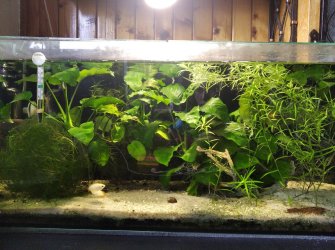Beastije
Fish Addict
Five weeks ago I bought a most likely pair of honey gourami. They were amazing,went to an established 54l tank. They stayed separated, interacted, slightly chased each other, utilized the whole tank, ate well.
Firday I noticed the more boisterous one, the one staying in the front of the tank (others place was the back of the tank), maybe slightly paler, suddenly resting on the substrate, on the leaves near the surface, gasping for air, bending to the side. I did an emergency 50% water change, water of a similar temp, not same. By the next day, the fish was dead. I didnt notice any symptoms prior, the fish was active, interactive, eating, pooping normally.
I feed a combination of live microworm, live baby brine shrimp, frozen daphnia/cyclop/bbs, dried food made with insects like fluval bug bites, sera vipan baby. Since this tank houses snails, I feed vegetables like peas and zucchini, so there is always a vegetable matter for the fish to eat during the week
Water is at 25 C, 5 cm or so gap between surface and coverglass to ensure humid air for them to breathe.
I am at a loss what has happened, since I didnt notice any symptoms prior, no redness, no nothing that would indicate this. I did however lose a large snail recently, but I did a water change after I discovered it. Should not have spiked so much to cause a sudden death, was few days before this incident.
I wonder for how long should I watch the other gourami, if it is worth obtaining a second one at some point ( I wanted a pair and try my hand at breeding them) and if I am not stressing the remaining gourami by leaving it alone in the tank.
Thank you
Firday I noticed the more boisterous one, the one staying in the front of the tank (others place was the back of the tank), maybe slightly paler, suddenly resting on the substrate, on the leaves near the surface, gasping for air, bending to the side. I did an emergency 50% water change, water of a similar temp, not same. By the next day, the fish was dead. I didnt notice any symptoms prior, the fish was active, interactive, eating, pooping normally.
I feed a combination of live microworm, live baby brine shrimp, frozen daphnia/cyclop/bbs, dried food made with insects like fluval bug bites, sera vipan baby. Since this tank houses snails, I feed vegetables like peas and zucchini, so there is always a vegetable matter for the fish to eat during the week
Water is at 25 C, 5 cm or so gap between surface and coverglass to ensure humid air for them to breathe.
I am at a loss what has happened, since I didnt notice any symptoms prior, no redness, no nothing that would indicate this. I did however lose a large snail recently, but I did a water change after I discovered it. Should not have spiked so much to cause a sudden death, was few days before this incident.
I wonder for how long should I watch the other gourami, if it is worth obtaining a second one at some point ( I wanted a pair and try my hand at breeding them) and if I am not stressing the remaining gourami by leaving it alone in the tank.
Thank you



